There’s no way around it: Big dogs are simply awesome.
They’re fun (if sometimes overwhelming) playmates, they make phenomenal snuggling companions, and most function as significant criminal deterrents, despite their often-gentle ways.
While there are dozens of breeds that qualify as “big” (which we arbitrarily and loosely defined as those weighing more than about 50 pounds), we’re restricting our focus to only the very biggest breeds today.
So, while Rotties, Dobies, Labs, Dalmatians, and German shepherds are pretty big by normal standards, you won’t find any of these “big” breeds on our list. The occasional Lab, for example, may tip the scales at 100 pounds; however, since most will fail to reach such sizes, they won’t be the focus of this article.
Instead, you’ll find a number of mastiffs, extra-large livestock guardians, and even a few hunting breeds among the 20 examined below. You’ll likely be familiar with some, but others are pretty rare breeds that you may have never seen.
But before you run out and add one of these behemoths to your family, you’ll need to understand the nature of care that gigantic dogs need. Big dogs certainly have plenty of awesome traits, but they’re also challenging in many respects.
Accordingly, we’ll also talk about some of the most important things to consider if you have your eye on a big breed.
Twenty of the Largest Dog Breeds in the World
We’ve put together 20 of the largest breeds in the world below.
The first couple of breeds are widely considered to be among the largest, but it’s harder to speak definitively once you get a little farther down the list, as there is plenty of variation in body size among individuals of any breed.
1. Great Dane

Great Danes are likely the tallest dog breed in existence.
One particularly tall individual – appropriately named Zeus – was 44 inches from paw to withers (essentially, his height at the shoulder). This earned Zeus (who unfortunately passed away in 2014) the title of “Tallest Dog Ever,” by Guinness World Records.
Great Danes also weigh quite a bit – most will easily eclipse the 100-pound mark, and the biggest individuals exceed 200 pounds. Fortunately, they’re usually very gentle with their families (including children), and they’re actually quite sensitive dogs who are pretty easy to train.
You’ll need to provide your Great Dane with plenty of exercise to prevent destructive behaviors from developing, and you’ll want to take your Great Dane with you as often as you can – they don’t like being left alone for long periods of time.
Because this big dogs require the biggest version of basically anything from extra-large dog beds and Great Dane-sized dog crates to large breed dog food, Great Danes can cost a lot to own. Not to mention those XL vet bills, as these dogs do tend to have joint issues due to their large stature.
2. Irish Wolfhound

If Great Danes are likely the tallest breed, Irish wolfhounds probably have second place locked up, as they often stand nearly 3-feet-high at the shoulders. They don’t have an especially robust build, but their large frame means that they sometimes weight 175 pounds or more.
Irish wolfhounds are easily some of the friendliest, goofiest, most playful dogs around, so most people would never guess that their ancestors were used on the battlefield and expected to hunt boar, bear, and other big prey.
Modern Irish wolfhounds excel in a number of competitive pursuits, including obedience trials and tracking games.
Irish wolfhounds are relatively chill by big dog standards, so they’re a good choice for owners that’ll struggle to find the time to go to the park for an hour every day. However, these big sighthounds still need regular exercise, so they’re best suited for owners with fenced yards.
3. Tibetan Mastiff

Tibetan Mastiff photo from Wikipedia.
Although they may look more like a bear than a canine, the Tibetan mastiff is all dog. They just happen to be one of the biggest breeds in the world, with one of the fluffiest, longest coats around.
In fact, many Tibetan mastiffs sport a small mane around their neck, head, and shoulder area, which further accentuates their imposing appearance.
Originally expected to guard livestock from predators, Tibetan mastiffs are more commonly kept as companion animals in the modern world. However, they still have all of the aptitudes and adaptations needed to work for a living.
Their long coats make them especially well-suited for cold climates, and their independence and intelligence make them a worthy adversary for wolves and other predators of sheep and goats.
Unfortunately, Tibetan mastiffs are not ideal for first-time dog owners. They aren’t people pleasers like many other breeds, and they can be quite territorial too. This makes them challenging to train, and they can be dangerous if not properly socialized from a young age.
4. Neapolitan Mastiff
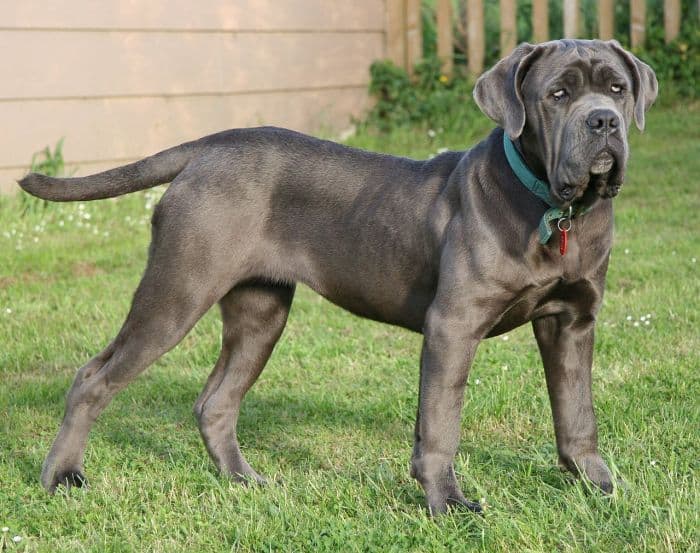
Neapolitan mastiff photo from Wikipedia.
A true giant, the Neapolitan mastiff routinely approaches 200 pounds in weight!
They’re undeniably imposing animals with huge heads and powerful builds, but they aren’t really that tall – few exceed 30 inches at the shoulder. And while most have pretty gentle and calm temperaments, their size and strength make them a poor choice for novices.
Hailing from Italy, these working dogs were originally used to guard people, territory, or livestock. Neapolitan mastiffs are pretty suspicious of strangers, but they are very affectionate with and protective of their families. They usually get along with kids well, but they won’t hesitate to move off and seek calmer surroundings – these are dignified dogs who demand decorum.
Like most other mastiffs, these pups drool more or less constantly, so they aren’t ideal for neat and tidy types. They also shed pretty heavily, but you can brush and bathe them regularly to help mitigate this issue.
The largest dog litter ever recorded was produced by a Neapolitan mastiff!
5. English Mastiff
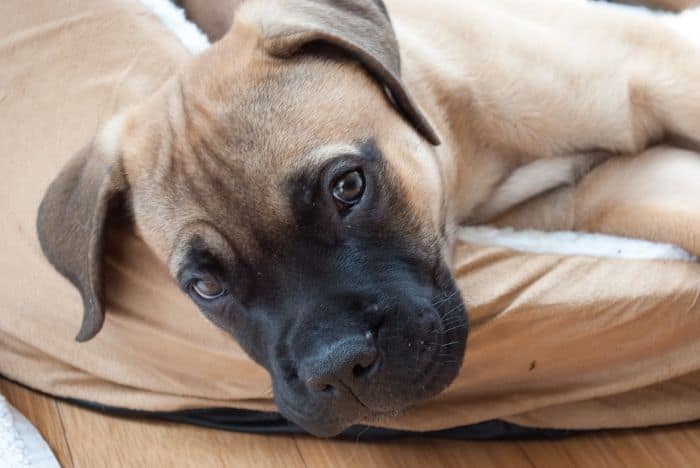
English mastiffs are massive dogs, but they aren’t especially tall. The biggest individuals may stand 32 inches high at the shoulder, but most are shorter than this. Regardless, you’d never confuse a mastiff with a small dog; these are thick and powerful canines, who occasionally exceed 200 pounds in weight.
Mastiffs aren’t the easiest dogs in the world to train. With all due respect to the breed, mastiffs aren’t exactly brilliant, and they don’t feel compelled to please their people the way many other breeds do.
Fortunately, despite the training challenges they present, mastiffs are generally big, slobbery softies, who are gentle and affectionate with their families.
Mastiffs aren’t always warm with strangers, so they should be socialized from an early age to ensure they remain friendly. Trust us, you don’t want to wait on it – socializing an aggressive adult mastiff is no easy task.
English mastiffs aren’t quite as sensitive as many other big breeds, and they’ll actually handle being left alone for brief periods pretty well. But they still expect to be treated like a member of the family – they won’t be happy living in the backyard all the time.
Need to feed your mastiff? Check out our favorite dog foods for mastiffs!
6. Spanish Mastiff
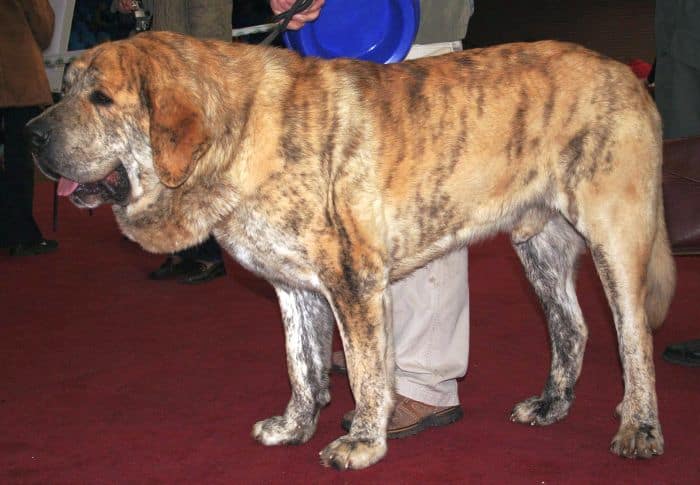
Spanish mastiff photo courtesy of Wikipedia.
Another behemoth of a breed, the Spanish mastiff routinely eclipses the 200-pound mark. They’re visually impressive dogs who would make most threats (including criminals and predators) think twice before acting.
With a history that stretches back more than two millennia, the Spanish mastiff has been used in a variety of contexts, but they all included guarding duties.
Modern members of the breed retain these protective instincts, and they’re rarely warm with strangers. Early socialization will help, as will their owner’s calm, confident leadership.
Because of their size and innate desire to protect their pack, Spanish mastiffs are probably not a good choice for inexperienced dog owners. However, experienced owners will likely find the Spanish mastiff’s intelligence and loyalty very endearing.
7. Saint Bernard
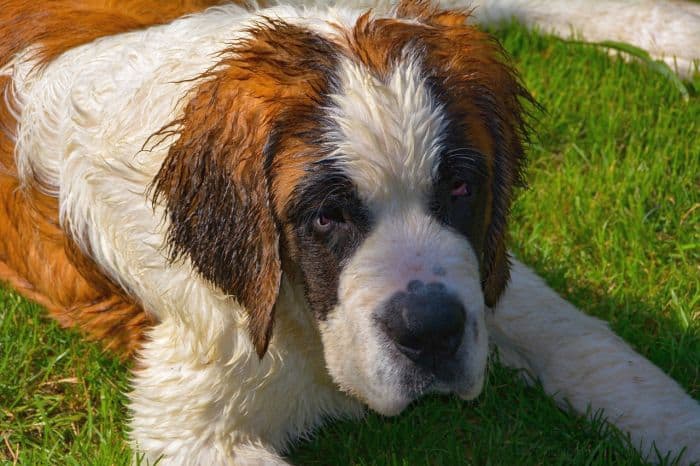
Saint Bernards are famous for finding and rescuing lost travelers amid the icy Swiss Alps, but they were also used as guard dogs during some portions of their history.
This may strike Saint Bernard owners as odd, given that these are some of the friendliest dogs on the planet – most make quick and easy friends with everyone they meet.
Weighing up to 175 pounds or more and occasionally standing 30 inches high at the shoulder, Saint Bernards are massive. This size makes them excellent dogs for drafting competitions, an event which requires the dogs to pull a weighted cart or wagon. Despite being somewhat challenging to train, Saint Bernards actually excel in obedience trials too.
Because of their size, build, and long coat, Saint Bernards are very poorly suited for warm climates, but they’ll feel right at home living in cold and snowy locations. They shed about as much as you’d expect, and they drool even more than you’d think possible, so they aren’t great for owners who demand a neat and tidy house.
8. Pakistani Mastiff
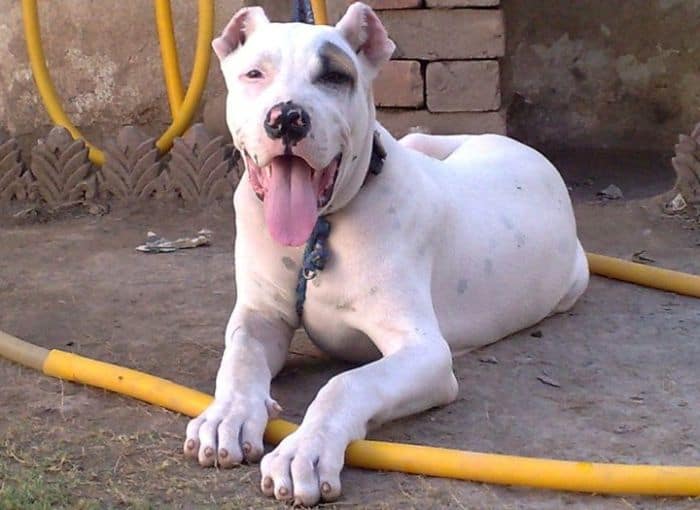
Pakistani mastiff photo from Wikipedia.
Also known by the name Bully Kutta, the Pakistani mastiff is an imposing breed.
Standing up to 33 inches tall at the shoulder, these are truly massive dogs who occasionally weigh 200 pounds or more. They are affectionate with their people, but they don’t warm up to strangers very quickly or easily.
Pakistani mastiffs are working dogs that have been used for a variety of purposes throughout their history. However, they were most commonly tasked with hunting and guarding duties. Today, they’re primarily kept as pets, although some farmers in southwest Asia continue to use them for livestock-guarding purposes.
Given their independent and bold nature, these dogs can be challenging pets, and they’re completely inappropriate for first-time owners. They do not automatically accept their owner’s authority, and they’ll often end up dominating wishy-washy family members (as well as children).
9. Boerboel
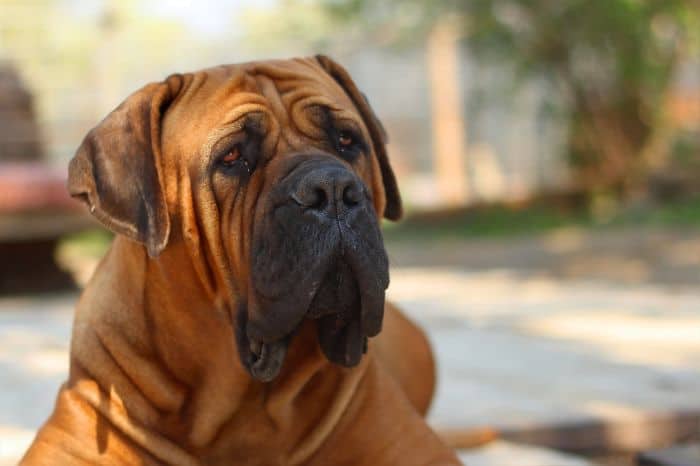
Also known as the South African mastiff, the Boerboel, like many other giant breeds with livestock-guarding backgrounds, is fierce and brave in the face of danger yet affectionate with his people.
Sensitive and family oriented, the Boerboel is a faithful companion who doesn’t enjoy being left alone very much.
Weighing up to 200 pounds despite only standing a little over 2 feet tall at the shoulder, the Boerboel is built like a tank. They’re incredibly muscular and athletic dogs who are nimbler than you may expect such a powerfully built animal to be.
They need plenty of room to roam and exercise, or they can become destructive and mischievous.
Even though Boerboels are pretty smart pups, they aren’t especially easy to train, thanks to their independent nature. Given this and their immense size, they’re not a great choice for novice owners.
They are, however, fantastic companions for those capable of instilling the type of firm yet loving discipline these dogs require.
10. Caucasian Shepherd Dogs
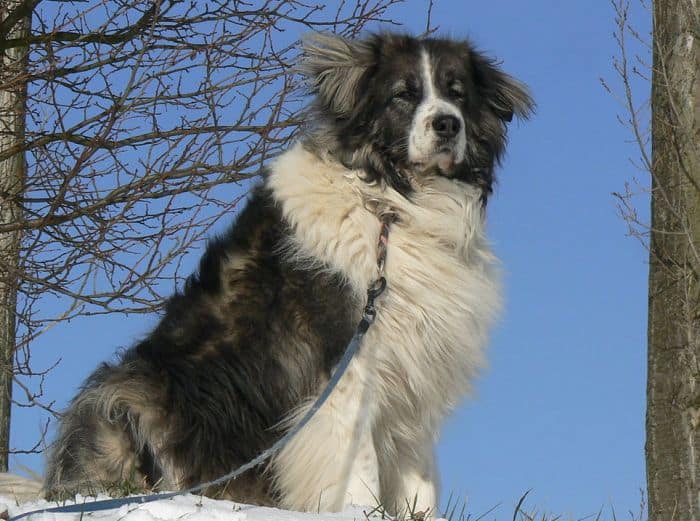
Caucasian shepherd dog photo from Wikipedia.
As you’d expect any dog that also goes by the name “Russian bear dog,” the Caucasian shepherd is a big canine.
Occasionally weighing more than 200 pounds and standing up to 34 inches high at the shoulder, Caucasian shepherds look even bigger than they are, thanks to their long, fluffy coats.
Caucasian shepherd dogs were originally tasked with guarding livestock from bears and other predators, and they are still used in these roles in the modern world. Some people also keep these massive pups as companion animals.
However, Caucasian shepherds retain a lot of their suspicious and territorial instincts, so they require plenty of socialization while they’re young.
Unfortunately, it can be a bit difficult to train Caucasian shepherds. They’re quite intelligent, but they’re used to figuring things out on their own, and they lack the people-pleasing instincts many other breeds have.
Accordingly, Caucasian shepherd dogs are only suitable for very experienced owners, and they’re completely unsuitable for novices.
11. Leonberger

Given that Leonbergers were originally created by mixing three other breeds on this list (Saint Bernards, great Pyrenees, and Newfoundlands), it shouldn’t come as a surprise that these are also pretty big dogs.
They aren’t especially tall (most individuals are around 28 to 30 inches tall), but big boys will weigh 170 pounds or more.
Despite their large size and intimidating appearance, Leonbergers are sensitive and affectionate dogs who don’t like to be away from their owners for very long at all. They are very suspicious of strangers, so early and frequent socialization is imperative.
Unfortunately, Leonbergers aren’t very easy to train, despite being reasonably intelligent dogs.
Generally speaking, Leonbergers are a bad choice for novice owners. If you do decide to add one to your family, be sure that you fence in the backyard, as these are energetic dogs who need plenty of room to run around.
Minimally, Leonbergers will require 30 minutes of high-octane playtime each day.
12. Great Pyrenees
One of the most celebrated and effective livestock-guarding breeds, the great Pyrenees is occasionally kept as a pet, but it remains one of the most popular choices for owners with sheep or other animals that require protection.
They are pretty comfortable being left alone for most of the day and night, although they are quite affectionate with their people.
Great Pyrenees can be challenging to train. They are very smart dogs, but they are also incredibly independent and march to the beat of their own drum. This makes them exquisitely well-suited for dealing with the kinds of challenges that may occur when predators threaten their flock at night, but it can make them difficult for novice owners.
Great Pyrenees aren’t all business – they are very playful dogs who often exhibit a youthful demeanor well into adulthood. But, this can make them a bit of a handful, given that they occasionally reach 160 pounds or more in weight.
Feed your Pyr the best! Check out 11 of the Best Great Pyrenees Dog Foods!
13. Presa Canario

Presa Canario photo courtesy of Wikipedia.
Officially called the Perro de Presa Canario, the Presa Canario is a massive breed who often weighs 160 pounds or more, despite only standing a bit more than 2 feet at the shoulder. They also have huge, blocky heads which make them seem even bigger than they actually are.
Originally used to protect cows from predators, Presa Canarios were also (and unfortunately) used in dog-fighting contexts up until the 1950s. This history is often still evident in modern members of the breed, as they’re often antagonistic toward other dogs.
Presas (as they’re often called) can also be quite suspicious of strangers, so early socialization and training are imperative.
Presa Canarios come in several different color varieties (including at least two different brindle patterns). They can drool quite a bit, but they’re typically not very heavy shedders.
Presa Canarios have pretty high energy levels, and they require frequent exercise and a large fenced yard.
14. Scottish Deerhound

Scottish deerhound photo courtesy of Wikipedia.
Scottish deerhounds are one of the lighter breeds on our list – they rarely weigh more than 110 to 120 pounds. However, their height (some individuals stand 32 inches high at the shoulder) and length make them hard to leave off.
Another hunting breed (they were expected to chase down deer), the Scottish deerhound is remarkably fast for such a large breed. And while they usually become pretty laid-back upon reaching maturity, they still need plenty of opportunities to run around and stretch their legs. A fenced yard is essentially mandatory for these dogs.
Training Scottish deerhounds is usually a bit challenging, as they are somewhat difficult to motivate. However, they’re very loving and affectionate dogs who tend to get along well with everyone, so these training challenges don’t usually cause many safety hazards.
They can, however, be hard to housebreak, so crate training is recommended.
15. Cane Corso
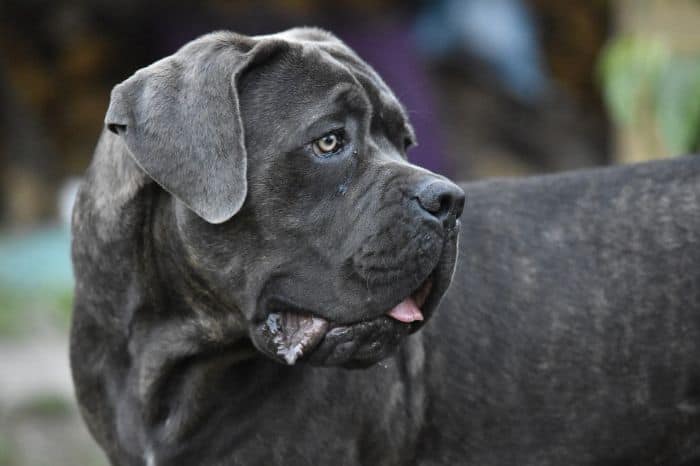
Believe it or not, the cane corso – one of the most revered guarding breeds in the world – is relatively small when compared to some of the other dogs on our list.
Big cani corsi (yeah, the breed has a weird plural form) stand a bit over 2 feet in height and only weigh about 100 to 120 pounds or so, but their giant, blocky heads and powerful bodies make them feel much bigger than they actually are.
Smart and relatively easy to train, the cane corso can make an excellent companion for experienced owners, but they’re a bit much for first-time owners. Unlike many of the other giant breeds, cani corsi are, above all else, people pleasers who want their owner’s love, affection, and praise. They will, however, challenge timid owners and test limits and boundaries regularly.
Cani corsi have very high energy levels, so they really need a big, fenced backyard that they can patrol on a daily basis, and they need occasional trips to the dog park too. Consider adding some mental and physical challenge to daily walks with walking training games like “barkour”.
But they shouldn’t be relegated to a solitary life in the backyard – these are pack-oriented pups who need to be with their people as much as is possible.
Feed your cane corso well! Check out 11 of the Best Cane Corso Dog Foods!
16. Dogue de Bordeaux
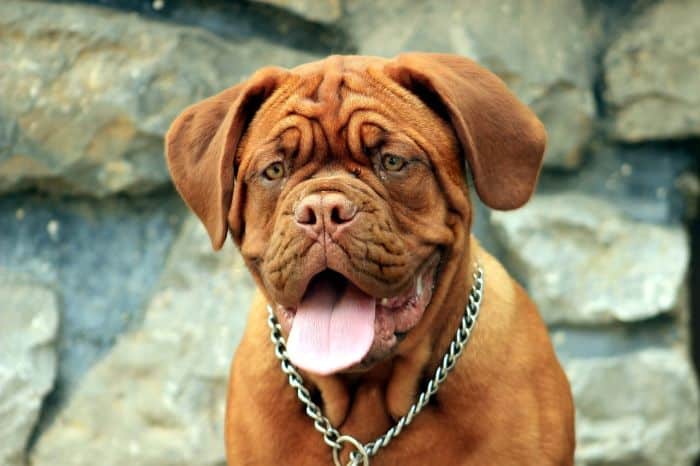
Before going further, let’s just take a minute to appreciate that face. Sure, it could use a bit of Botox around the cheeks, and it’s painted with a permanent coating of drool, but you have to love the Dogue de Bordeaux’s unamused, yet understanding expression.
That’s the kind of face you want to come home to after a long Monday at the office!
Let’s just hope that your home is still intact when you arrive – these sensitive, loving, and loyal pups can become anxious and bored when left alone for long periods of time, which can trigger destructive chewing behaviors.
In fact, while they need plenty of opportunities to run around outside and blow off steam, they love nothing more than couch-cuddling with mom or dad.
The Dogue de Bordeaux is certainly lovable, but this breed will probably prove too challenging for most novice owners. They are 120 pounds of muscle and mischief and can be very difficult to control if not properly trained and socialized.
17. Anatolian Shepherd
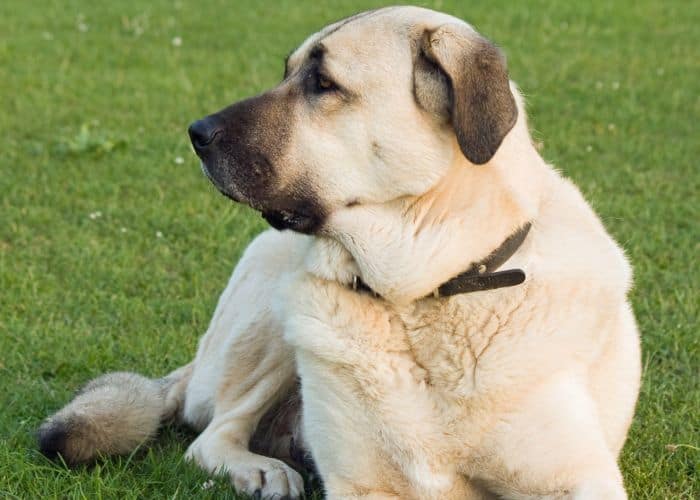
The Anatolian shepherd is – as its name implies – another livestock-guarding breed. However, these large dogs (who occasionally exceed 150 pounds in weight) are a bit different from many other breeds expected to protect sheep and other animals.
For starters, the Anatolian shepherd is a bit easier to train than most other flock-guarding breeds. They are intelligent and sensitive, which are helpful characteristics you can leverage for training purposes.
However, they aren’t especially affectionate – even with their favorite people. They have a no-nonsense demeanor and remain on constant alert for threats.
Anatolian shepherds can become a bit overprotective if not properly socialized, and although they are usually gentle with kids, they will rarely respect the children’s position in the household hierarchy.
Accordingly, Anatolian shepherds aren’t a great choice for many families, and they are best left to experienced owners who can devote the time and effort to properly socializing and training these powerful dogs.
18. Newfoundland
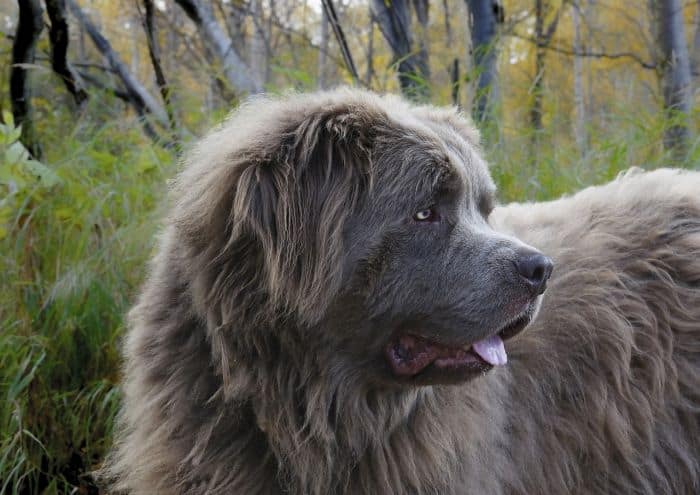
One of the best dogs on our list for novice owners, the Newfoundland is truly a gentle giant.
Unlike many of the other giant breeds who were developed to guard livestock, people, or property, Newfoundlands are working dogs who were expected to help fishermen work their nets and haul things around.
Relatively Lab-like in personality, Newfoundlands are gentle with their families (including children – they’re phenomenally tolerant of youngsters), and they’re usually pretty warm with strangers too.
They aren’t the biggest dogs on our list, but the biggest Newfies (as they are sometimes called) can weigh up to 150 pounds or so. And thanks to their long coats, they look even bigger.
Newfoundlands are pretty easy to train, and they have reasonable exercise needs, so they’re a pretty good choice for families who want a big dog. They do shed enough hair to coat your home three-times over, but you can try to mediate this through frequent outdoor brushings and a vaccum designed to suck up pet hair.
Check it out: 11 of the Best Dog Foods for Newfoundlands!
19. Bullmastiff
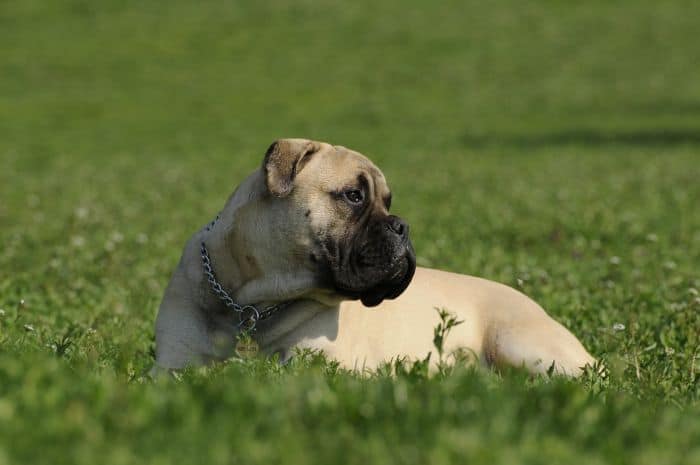
One of the smaller members of the mastiff group, the bullmastiff is still a large and impressive dog. They aren’t especially tall (most are only a bit over 2 feet tall at the shoulder), but they’re very thick dogs who routinely reach 120 to 130 pounds or so.
A true protector at heart, the bullmastiff is extremely loving with his family (including children), but he is always ready to act if need be. They aren’t terribly difficult to train, as they’re fairly intelligent and love to please their owners, but early socialization is crucial.
They are pretty sensitive dogs, so be sure to avoid harsh training methods and rely instead on positive reinforcement.
Bullmastiffs have relatively low energy levels, and they don’t need the kind of high-octane exercise some of the other breeds on this list require. Just be sure that you watch his body weight and feed him a good food, as bullmastiffs can quickly pack on the pounds if overfed or given low-quality eats.
20. Greater Swiss Mountain Dog
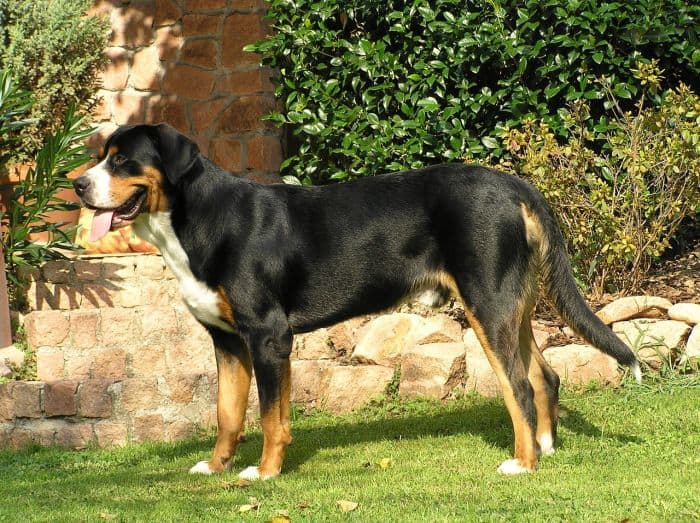
One of the smaller breeds on our list, the Greater Swiss mountain dog is actually the biggest member of its ancestral breed group – the Sennenhund. Most Greater Swiss mountain dogs are probably around 100 pounds in weight, but the biggest individuals may exceed 140 pounds and stand 28 inches at the shoulder.
Greater Swiss mountain dogs are pretty friendly and gentle, although they can be a bit reserved around strangers.
They’re chock full of energy, so they need plenty of exercise and training to help give them something to do, but if provided with the opportunity to burn off excess energy, they can make good pets for beginners.
Like many other livestock-guarding breeds, Greater Swiss mountain dogs think for themselves, so early obedience training is important. Note that Greater Swiss mountain dogs can be aggressive around smaller pets, so make introductions carefully.
Considerations and Cautions: Things to Think About Before You Buy a Big Dog

It’s important to think carefully before you add any dog to your family, but gigantic breeds present additional challenges which go above and beyond those presented by dogs of more modest size.
We’ll discuss a few of the most notable aspects of giant-dog-ownership you need to think about below.
Big dogs have big appetites.
A dog’s caloric needs more-or-less vary with size (technically, smaller dogs will require slightly more food per pound of body weight than larger dogs will, but the difference is negligible from a consumer point-of-view).
So, while a Yorkie may get by with less than a cup of food every day, a gigantic Mastiff may need ten cups or more day-in, day-out.
This all sounds pretty intuitive, but let’s put that into context.
- A 10-pound dog will need about 1 cup of food per day (this figure obviously fluctuates based on a variety of factors, but stick with me).
Such a dog would need about 30 cups of food each month. Every pound of dog food contains about 4 cups. So, a 10-pound bag of food would last you more than a month.
- By contrast, our hypothetical 200-pound mastiff may need 10 cups of food a day. That’s 2 ½ pounds of food per day, meaning your big baby would tear through a 50-pound bag of food in as little as 3 weeks.
You should probably decide on your preferred large dog breed food and then run the numbers to figure out how much you’ll be spending on food each month before you add a gigantic dog to your family.
Big dogs often present problems for renters.
Many apartment complexes and private property managers have adopted more pet-friendly policies than were common in the past, but it can still be tough to find places that’ll accept large or gigantic breeds.

There are rental properties out there for people with big pets, but they aren’t especially common. Accordingly, you’ll often need to make sacrifices in other areas. You may have to pay more than you’d like, live farther from town than is ideal, or settle for a place that you may not really love.
And even if you are currently renting a wonderful place for a big dog, things can change, apartment complexes may alter their policies, and the yearly rent increase may eventually price you out of your place.
Big dogs are often more expensive to insure.
Whether you’re looking for renter’s insurance or you need a homeowner’s insurance policy, you’ll find that many companies will charge more for people with big dogs. Some won’t even cover large breeds at all.
This is understandable from the insurer’s point of view, even if it doesn’t feel very fair to those of us with big pups. Even the gentlest giant breed can accidentally injure people, and big dogs can cause a lot more property damage than tiny dogs.
There’s not a whole lot you can do to get around this except to shop around for the best insurance policy and rates you can find. Be sure to talk to other dog folks living in your area, as they may have found companies with big-dog-friendly policies.
Big dogs usually get big veterinary bills.
Big dogs often present veterinary challenges that small dogs don’t. They can require more person-power to control during unpleasant procedures, they need larger supplies and equipment, and they usually need greater quantities of medicine than smaller dogs do.
So, while a 5-pound poodle and a 150-pound Newfoundland may both go in for a yearly checkup and set of vaccinations, the owners will likely receive very different bills for the services provided.
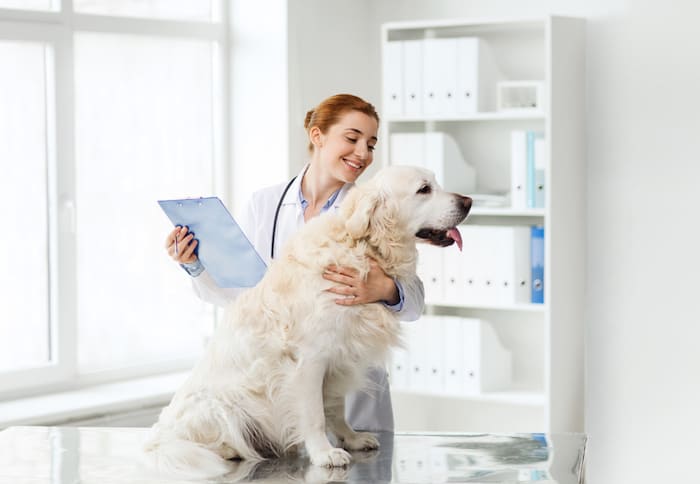
Everything you buy for a big dog will be more expensive.
Almost every product you buy for a big dog will cost more than those designed for smaller dogs. For starters, these products will all require more materials than smaller items, and they must often be designed or constructed differently in order to withstand the wear-and-tear a big breed can inflict.
For example, your Saint Bernard will quickly destroy chew toys suitable for Chihuahuas – he’ll need toys designed for tough canines!
He’ll also need bigger food and water dishes, larger collars, and bigger leashes.
But perhaps more significant than any other products, large dog beds and crates suitable for giant dogs are much more expensive than those designed for lap dogs.
You’ll have trouble finding big enough versions of some dog-related products.
Paying more for your big dog’s food bowls is one thing, but you’ll often find it hard to simply find some products in sizes befitting big breeds. There aren’t many gaping holes in the market, but you’ll rarely be able to choose from as many manufacturers as other dog owners will.
For example, a few manufacturers do make beds in large enough sizes for big dogs, but you won’t be able to choose from dozens of different manufacturers and brands when picking one.
Be sure to think carefully before adding a big dog to your family and be sure that you find one with a personality that’s compatible with yours.
If you’re new to dogs and just want a gigantic and gentle family pet, the Greater Swiss mountain dog, Saint Bernard, or Newfoundland may fit the bill.
If you’re more experienced and would like a loyal but protective companion, it’s hard to go wrong with an English mastiff or Great Dane.
Me? I’d probably pick a boerboel, but I’ve always liked cani corsis and Great Danes too. No matter what you’re looking for, you should find a couple of good candidates above.
Do you already have a gigantic pup ambling around your home? Tell us all about him! What do you like most about your huge dog? What kinds of things do you wish you’d have thought of before adding him to your family?
Let us know your thoughts and experiences in the comments below.
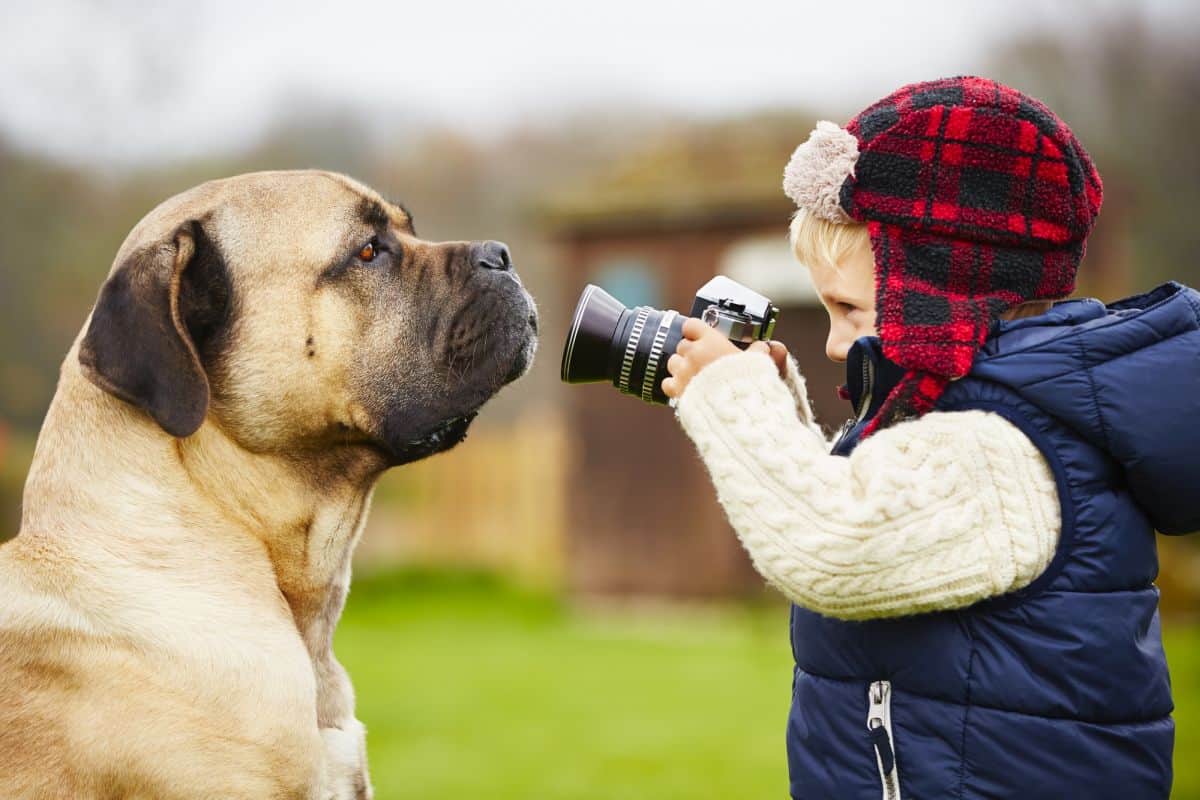




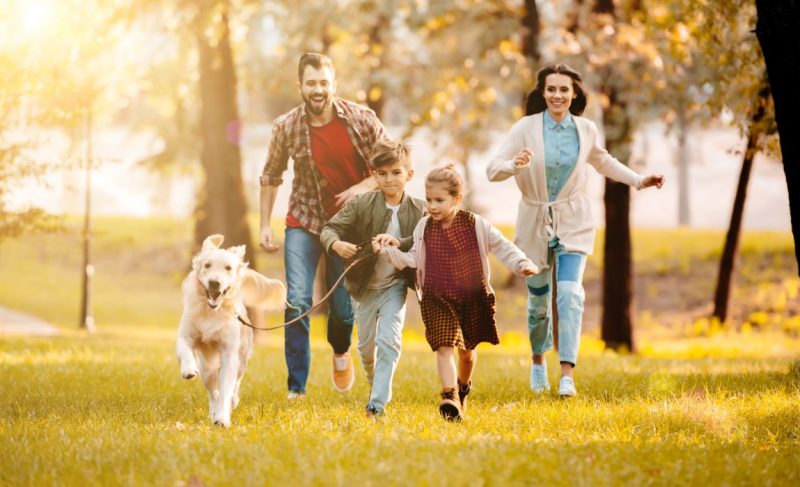
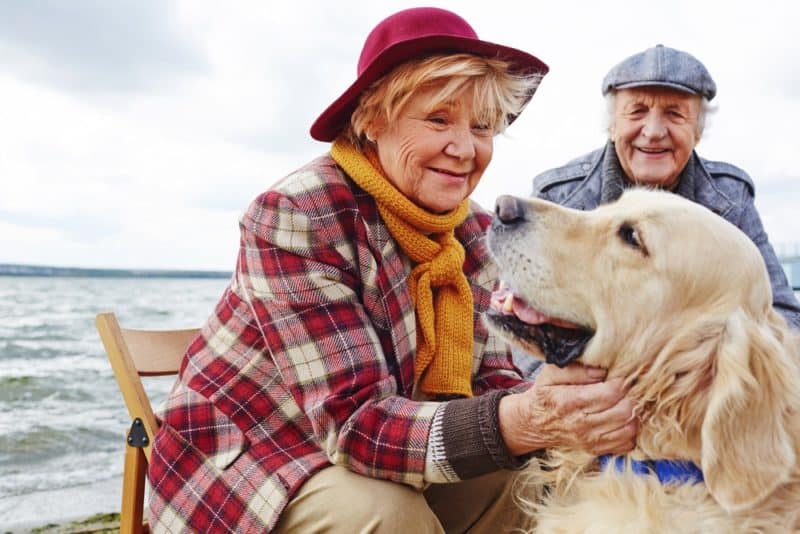

Leave a Comment